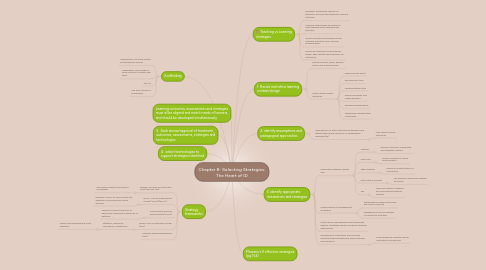
1. Learning outcomes, assessments and strategies must all be aligned and match needs of learners, and should be developed simultaneously
2. 4. select technologies to support strategies identified
3. 5. Seek review/approval of treatment, outcomes, assessments, strategies and technologies
4. Strategy frameworks
4.1. Gagne- 9 events of instruction (Inst) (pg 168-169)
4.1.1. can model cognitive processes for learners
4.2. BSCS- Five Es instructional model (Const) (pg 171)
4.2.1. Primarily in face-to-face but can be adapted for synchronous online learning
4.3. Connectivist learning environments (Conn)
4.3.1. Learners connect new info to personally meaningful resources, or patterns
4.4. Keller's ARCS motivation model (any)
4.4.1. attention, relevance, confidence, satistaction
4.4.1.1. choice and challenge are most effective
4.5. Scenario planning guidelines (any)
5. Scaffolding
5.1. Supplantive= do more mental processing for learner
5.2. Generative= encourage or allow learners to define own goals
5.3. pg 165
5.4. Job aids as type of scaffolding
6. Teaching vs Learning strategies
6.1. Teaching: techniques used by an instructor to bring about specific learning outcome
6.2. Learning: steps taken by learner to make learning more efficient and effective
6.3. Constructivist and connectivist use "learning activities" and "learning environments"
6.4. Should be selected to meet learner needs- they dictate the outcomes for instruction
7. 1. Revisit and refine learning context design
7.1. Decide on time, place, delivery mode, and learner groups
7.2. Other factors affect decisions
7.2.1. resources and funds
7.2.2. development time
7.2.3. implementation time
7.2.4. learner familiarity and responsiveness
7.2.5. available infrastructure
7.2.6. stakeholder wishes/other constraints
8. 2. identify assumptions and pedagogical approaches
8.1. Assumptions of both instructional designer and stakeholders guide selection of pedagogical approach(es)
8.1.1. May need to group outcomes
9. 3. identify appropriate interactions and strategies
9.1. Interaction between learner and
9.1.1. content
9.1.1.1. learners consume, manipulate and interpret content
9.1.2. instructor
9.1.2.1. reduce isolation in virtual environments
9.1.3. other learners
9.1.3.1. improve communication & connection
9.1.4. instructional context
9.1.4.1. can enhance learning by adding to realism
9.1.5. self
9.1.5.1. reflection helps to develop self-directed and lifelong learners
9.2. Organizational vs engagement strategies
9.2.1. organizational=define structure and flow of learning
9.2.2. engagement=involve learners in interactive activities
9.3. Instructional management and technology delivery strategies deliver and direct learning experiences
9.4. Designing for interaction may be more important with blended and online learning environments
9.4.1. social presence impacts learner motivation and learning

